The ensuing rescue attempts and successful recovery of the
sunken submarine were major events in the history of Navy diving
and salvage. Raising F-4 was done under the technical direction
of Naval Constructor Julius A. Furer in April-August 1915. Initially,
cables were dragged under her hull and she was lifted and towed
into shallower water during May. While taking part in the extremely
deep diving activities involved in this phase of the operation,
Navy Diver Frank
W. Crilley performed an act of heroism for which he received
the Medal of Honor.
Photo #: NH 74736
USS F-4 (SS-23)
Photographed in 1913-15.
Courtesy of Donald M. McPherson, 1972.
U.S. Naval Historical Center Photograph.
Online Image: 75KB; 465 x 765 pixels |
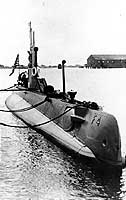 |
Photo #: NH 63259
Submarines and their crews at Honolulu, Hawaii, in 1914
These boats are (from front to back): USS F-4 (SS-23),
USS F-2 (SS-21), USS F-3 (SS-22) and USS F-1
(SS-20).
The U.S. Army Transport Dix is in the background.
Note the "fish" flags and 13-star "boat"
ensigns flown by these submarines.
Photographed by Noggle.
U.S. Naval Historical Center Photograph.
Online Image: 81KB; 740 x 295 pixels |
 |
Photo #: NH 74731
Salvage of USS F-4 (SS-23), April-August 1915
A diver descending to the sunken submarine. Photographed 90 feet
below the surface.
F-4 had sunk on 25 March 1915 off Honolulu, Hawaii, in
over 300 feet of water.
Courtesy of Donald M. McPherson, 1972.
U.S. Naval Historical Center Photograph.
Online Image: 133KB; 740 x 620 pixels |
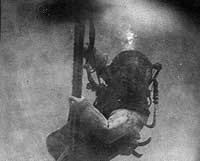 |
Photo #: NH 43497
Salvage of USS F-4 (SS-23), April-August 1915
Valve manifold and hose leads to submerged pontoons, on board
a salvage vessel off Honolulu, Hawaii, probably in August 1915.
This equipment was devised by Naval Constructor Julius A. Furer.
Halftone photograph, copied from "Transactions of the Society
of Naval Architects and Marine Engineers", Volume 24, 1916,
Figure 11.
The tug in the left distance is probably USS Navajo.
U.S. Naval Historical Center Photograph.
Online Image: 104KB; 740 x 535 pixels |
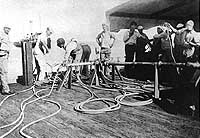 |
Photo #: NH 43498
Salvage of USS F-4 (SS-23), April-August 1915
Bow salvage pontoons emerging from the depths, off Honolulu,
Hawaii, circa 29 August 1915, during the final lifting of the
sunken submarine. The salvage equipment was devised by Naval
Constructor Julius A. Furer.
Halftone photograph, copied from "Transactions of the Society
of Naval Architects and Marine Engineers", Volume 24, 1916,
Figure 12.
U.S. Naval Historical Center Photograph.
Online Image: 70KB; 740 x 555 pixels |
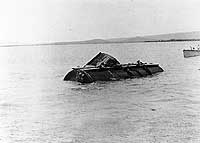 |
Photo #: NH 43499
Salvage of USS F-4 (SS-23), April-August 1915
All salvage pontoons on the surface, off Honolulu, Hawaii, circa
29 August 1915, with preparations under way to tow the sunken
submarine into Honolulu Harbor. The salvage equipment was devised
by Naval Constructor Julius A. Furer.
Halftone photograph, copied from "Transactions of the Society
of Naval Architects and Marine Engineers", Volume 24, 1916,
Figure 13.
The tug in the center is probably USS Navajo.
U.S. Naval Historical Center Photograph.
Online Image: 102KB; 740 x 570 pixels |
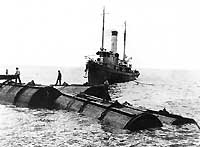 |
Photo #: NH 74732
Salvage of USS F-4 (SS-23), April-August 1915
Salvage pontoons on the surface, off Honolulu, Hawaii, circa
29 August 1915, after the final lifting of the sunken submarine
in preparation for towing her into Honolulu harbor.
Note wooden protective sheathing around the pontoons. Salvage
equipment was devised by Naval Constructor Julius A. Furer.
The tug at right is probably USS Navajo.
Courtesy of Donald M. McPherson, 1972.
U.S. Naval Historical Center Photograph.
Online Image: 82KB; 740 x 455 pixels |
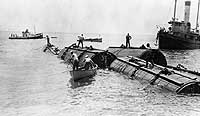 |
Photo #: NH 74733
Salvage of USS F-4 (SS-23), April-August 1915
F-4 in drydock at Honolulu, Hawaii, on 1 September
1915, after she had been raised from over 300 feet of water and
towed into port. Note the large implosion hole in her port side,
and the salvage pontoons used to support her during the final
lift.
This view shows F-4's port bow. She is upside down, rolled
to starboard approximately 120 degrees from the vertical.
Photographed by Kodagraph, Honolulu.
Courtesy of Donald M. McPherson, 1972.
U.S. Naval Historical Center Photograph.
Online Image: 96KB; 740 x 485 pixels |
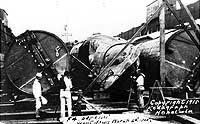 |
Photo #: NH 74734
Salvage of USS F-4 (SS-23), April-August 1915
Naval personnel examine the large implosion hole in F-4's
port side, in drydock at Honolulu, Hawaii, circa late August
or early September 1915. She had been raised from over 300 feet
of water and towed into port.
This view was taken from off the port bow, showing the submarine's
port side diving plane in the center. She is upside down, rolled
to starboard approximately 120 degrees from the vertical.
Courtesy of Donald M. McPherson, 1972.
U.S. Naval Historical Center Photograph.
Online Image: 80KB; 740 x 465 pixels |
 |
Photo #: NH 74735
Salvage of USS F-4 (SS-23), April-August 1915
View of F-4's port side name plate, taken in drydock at
Honolulu, Hawaii, circa late August or early September 1915,
after she had been raised from over 300 feet of water and towed
into port.
These figures are mounted on the submarine's port bow, and are
shown upside down, as she was drydocked rolled to starboard approximately
120 degrees from the vertical.
Courtesy of Donald M. McPherson, 1972.
U.S. Naval Historical Center Photograph.
Online Image: 128KB; 740 x 465 pixels |
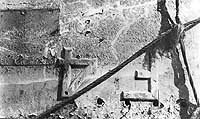 |
Photo #: NH 84383
U.S. Submarines Number 20 through 23
General plans prepared by the Fore River Shipbuilding Company,
Quincy, Massachusetts, 18 June 1910. This sheet features inboard
and outboard profile drawings.
These submarines were constructed by the Union Iron Works, San
Francisco, California. Initially named Carp (Submarine
# 20), Barracuda (Submarine # 21), Pickerel (Submarine
# 22) and Skate (Submarine # 23), they were renamed F-1
through F-4 in November 1911, while under construction.
The original plan is in Record Group 19 at the U.S. National
Archives.
U.S. Naval Historical Center Photograph.
Online Image: 210KB; 1200 x 805
pixels |
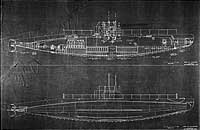 |
Photo #: NH 84382
U.S. Submarines Number 20 through 23
General plans prepared by the Fore River Shipbuilding Company,
Quincy, Massachusetts, 18 June 1910. This sheet features a table
of dimensions, deck plans and hull section drawings.
These submarines were constructed by the Union Iron Works, San
Francisco, California. Initially named Carp (Submarine
# 20), Barracuda (Submarine # 21), Pickerel (Submarine
# 22) and Skate (Submarine # 23), they were renamed F-1
through F-4 in November 1911, while under construction.
The original plan is in Record Group 19 at the U.S. National
Archives.
U.S. Naval Historical Center Photograph.
Online Image: 202KB; 1200 x 715
pixels |
 |
